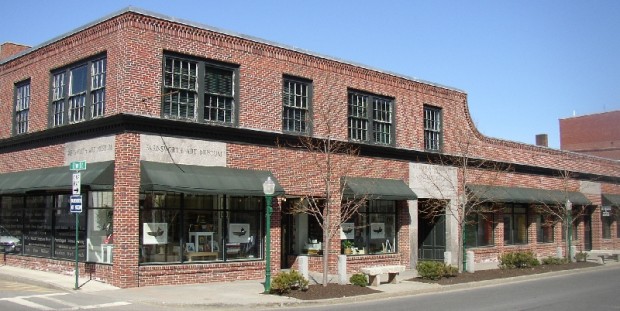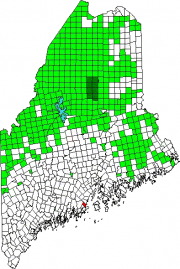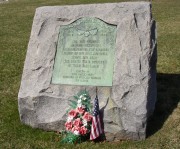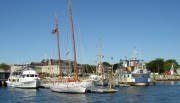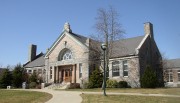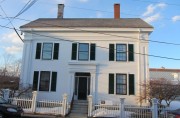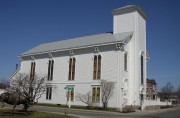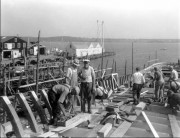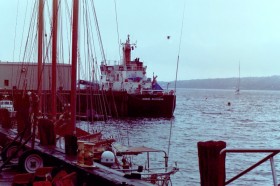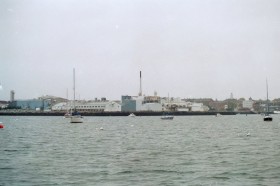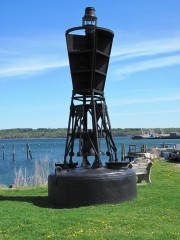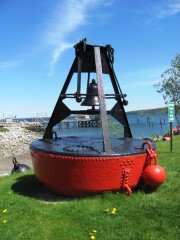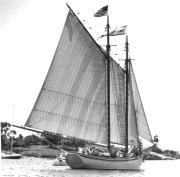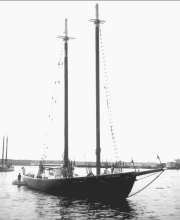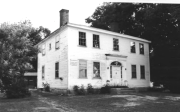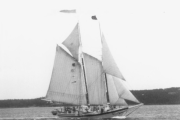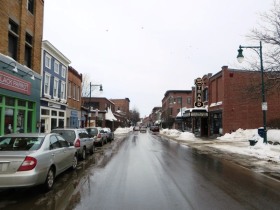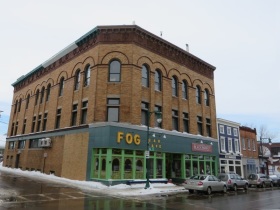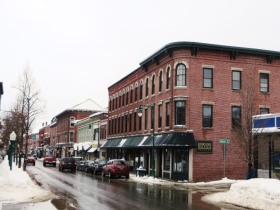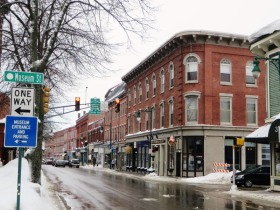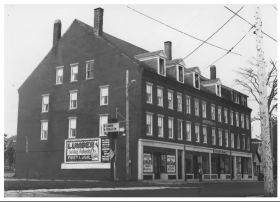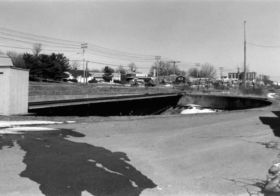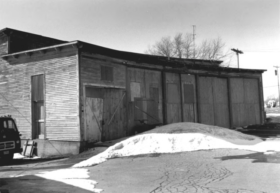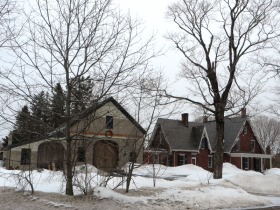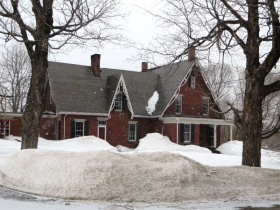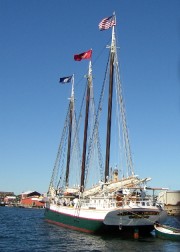| Year | Population |
|---|---|
| 1970 | 8,505 |
| 1980 | 7,919 |
| 1990 | 7,972 |
| 2000 | 7,609 |
| 2010 | 7,279 |
| Geographic Data | |
|---|---|
| N. Latitude | 44:30:48 |
| W. Longitude | 69:26:08 |
| Maine House | District 93 |
| Maine Senate | District 12 |
| Congress | District 2 |
| Area sq. mi. | (total) 39.5 |
| Area sq. mi. | (land) 38.9 |
| Population/sqmi | (land) 565.7 |
County: Knox
Total=land+water; Land=land only |
|
Clipper Ships Built Here
- Springbok–1851
- Defiance–1852
- Rattler–1852
- Anglo Saxon–1853
- Live Yankee–1853
- Progressive–1853
- Red Jacket–1853
- Euterpe–1854
- Yankee Ranger–1854
- Young Mechanic–1856
[ROCK-lnd] is a city in, and the county seat of, Knox County. It incorporated as the town of East Thomaston from a portion of Thomaston on July 28, 1848, changed its name in 1850, and became a city in 1854. Rockland swapped some land with Thomaston in 1849 and 1852 and has kept its boundaries intact ever since.
Settled in 1769, the community still maintains the working waterfront characteristic of its glory days as a major fishing port. The world’s fastest clipper ship, Red Jacket, was built here; Edna St. Vincent Millay was born here, and the well appointed William A. Farnsworth Art Museum makes its home here. Artist Louise Nevelson lived here as a young girl and graduated from Rockland High School in 1918.
Nathan A. Farwell was a longtime resident of Rockland; he served in the state legislature, House and Senate (where he was President), and as a U.S. Representative. U.S. Representative Charles E. Littlefield was also a resident and state legislator. Edward Moran, also a U.S.Representative, was born here and remained a longtime resident.
Actor, star of stage and movies, Maxine Eliot, was born in Rockland in 1873. It is also the birthplace of Abbie Burgess Grant, an early female lighthouse keeper.
The city has been home to at least three members of the U.S. Congress. Samuel Clement Fessenden was the judge in the municipal court in the late 1850’s and was elected to Congress as a Republican in 1860. Edward C. Moran, a veteran of World War I, served as a Democrat in the 1930’s.
More recently, David Emery, born in Rockland, was elected to four terms in Congress beginning in 1974. Governor (from 1905-1909) William T. Cobb was born in Rockland in 1857. Business owner and U.S. Senator Obadiah Gardner was a resident of the city.
Lobster is still king in Rockland, which hosts the annual Maine Seafood Festival. It is held in the waterfront park, probably not far from where ships were being built in the 1940’s.
Located on U.S. Route 1 and Maine Routes 17 and 73, the city is a regional service and retail center. Most recently, new service industries and people seeking waterfront residential property have begun to transform the once working class atmosphere.
Congressional Medal of Honor recipient
(1861)
Form of Government: Council-Mayor-Manager.
Additional resources
(George French photo, “Maine Carpenters in Rockland Harbor,” courtesy of Maine State Archives)
Clark, Lewis Bates. A Brief Economic History of the City of Rockland, Maine. 1931. [Thesis at Fogler Library].
East, Marjorie. The Rockland Public Library: Its First Hundred Years. Rockland, Me. Friends of the Rockland Public Library. 1998.
Eaton, Cyrus. History of Thomaston, Rockland, and South Thomaston, Maine, from Their First Exploration, A. D. 1605; with Family Genealogies. Hallowell, Me. Masters, Smith. 1865.
MacLachlan, Courtney C. Rockland Area Lime Industries. Charleston, SC. Arcadia. 2006. [University of Maine, Raymond H. Fogler Library, Special Collections; Maine State Library]
*Maine. Historic Preservation Commission. Augusta, Me.
Meyer, Mary-Louise. The Farnsworth Story. Rockland, Me. The Farnsworth Art Museum, 1998.
Richardson, Eleanor Motley. Mechanic Street: Uncovering the History of a Maine Neighborhood. Rockland, Me. Red Barn Publishing. c2008. [University of Maine, Raymond H. Fogler Library, Special Collections; Maine State Library]
Rockland Bicentennial Commission. Shore Village Story: an Informal History of Rockland, Maine. Rockland, Me. The Commission. c1976.
Sylvester, Sandra. Beyond the South End. Rockland, Me. Blog entry. March 12, 2012. (accessed October 23, 2014)
National Register of Historic Places – Listings
Maine. Historic Preservation Commission. Full text and photos are at https://npgallery.nps.gov/nrhp
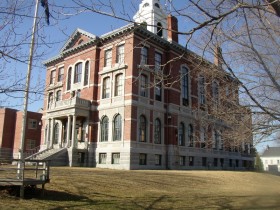
Knox County Courthouse, |

Main Street Historic District, |
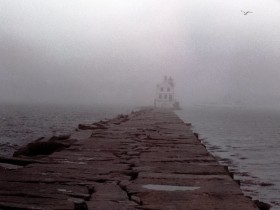
Rockland Breakwater, |
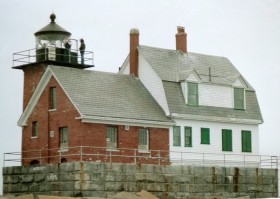
Rockland Breakwater Lighthouse, Rockland Harbor |
AMERICAN EAGLE (schooner), National Historic Landmark
[Rockland Harbor] The American Eagle, built in 1930, marked an important transition in the fishing industry of the United States, then centered at the port of the schooner’s origin, Gloucester, Massachusetts. A 300-year tradition of building sailing fishing schooners at Gloucester and nearby ports ended in 1930. [Bart Discitello photo]
The rise of motor power doomed the sailing schooner. In its place a new auxiliary schooner was built beginning around 1900. The auxiliary schooner was the forerunner of the modern trawler. American Eagle, the oldest known Gloucester combination power and sailing fishing boat left afloat, is the earliest example of this transitional type.
After fifty-five years in service, including time as a motor-powered trawler, American Eagle was restored to her auxiliary sailing rig and placed in service as a “Maine Windjammer,” in 1986, carrying passengers as part of a “dude fleet” that dates to the 1930s, promoting the concept of adaptive use of historic vessels.*
Blackjack(Friendship sloop)
The Blackjack is a single-masted, Friendship sloop designed and built in 1900 by Wilbur Morse in Friendship, Maine. The ship is now [2020] berthed at the Sail, Power and Steam Museum in Rockland, Knox County, Maine. Designed as a 33′ fishing sloop, she was used in various fisheries and occasionally as a coastal trader for thirty-five years before being converted to a personal yacht in 1935. In 2014 she was donated by William Magee to the Sail, Power and Steam Museum and restored to her original design between 2016-18. Although currently fitted out as a fishing sloop, she is used as an educational vessel providing sailing lessons and day trips from the museum. The original design and rig have been restored reflecting a typical Friendship sloop designed to fish and lobster along the mid-Maine coast with adaptability for multiple uses and sailing environments. Blackjack is eligible for listing in the National Register under Maritime History at the local level with a period of significance from her 1900 construction date to 1935 when she ceased to fish. She is a good example of the hull characteristics and general fishing form of the working Friendship sloop type during the period of significance and conveys the importance of this type of boat to ca. 1900 maritime activities along the Maine coast. Friendship sloops were once common along the mid-coast of Maine, and the Blackjack is one of the oldest of the type with a working design and the integrity to convey the significance of the Friendship sloops place in maritime history.
Farnsworth Homestead
[21 Elm Street] William A. Farnsworth was a prominent and prosperous businessman who gained his income from lime-rock property and the Rockland Water Company, which he founded and ran as President. About 1854 he built the large wood frame Greek Revival house, now known as the Farnsworth Homestead.
Based on a bequest by his daughter Lucy who died in 1935, the Farnsworth Homestead was restored exactly as a middle class example of the Post Federal era and was opened to the public. The William A. Farnsworth Library and Art Museum was opened in 1948 as a memorial to her father.* [See photo above.]
ISAAC H. EVANS (schooner), National Historic Landmark
[Rockland Harbor] This schooner was at built Mauricetown, N.J. in 1886, under the name Boyd N. Sheppard, as an oyster freighter. She worked the oyster beds of Delaware Bay, carrying New Jersey oysters to market in New York.
Early in 1909, she was sold to Edgar, Norman, and Joshua Evans of New Jersey, and continued oystering. The three Evans renamed the schooner for their father in 1919. As Isaac H. Evans, the schooner continued to work under sail until 1946. It was converted to a motor vessel, which were then allowed to work oysters.
After more than a century in service, including time as a motor-powered vessel, Isaac H. Evans was restored to her sailing rig and placed in service as a “Maine Windjammer,” in 1972, carrying passengers as part of a “dude fleet” [see American Eagle].*
J. & E. RIGGIN (schooner), National Historic Landmark
[Rockland Harbor] J. & E. Riggin was built at Dorchester, New Jersey in 1927 for use as an oyster dredger and freighter. Owned by Charles Riggin, the schooner was named for his sons, Jacob and Edward.
Riggin continued under sail until 1946, when a change in the laws of New Jersey allowed oyster dredging under power. That year, it, like many other oyster sloops and freighters, was converted to a motor vessel. She continued to work through the decline of oystering, marked by the destruction of many vessels in the Great Hurricane of 1938 and the Second World War. [Photo not attributed]
In 1974 J. & E. Riqqin was purchased by David and Susan Allen of Rockland, and restored to serve in the windjammer fleet after serving as a dragger out of Cape Cod. Riggin joined the fleet, which included Isaac H. Evans, restored in 1971, and Lewis R. French, restored between 1973 and 1976. The fleet, collectively run as “Maine Windjammer Cruises,” was augmented by the arrival of the Gloucesterman American Eagle, restored in 1986.*
Knott Crockett House
[750 Main Street] Probably built in 1825, this elaborate Federal style structure was the longtime residence of Knott Crockett. Crockett (1792-1857) was a descendent of an early settler in the Rockland area who opened a general store in 1817. In the 1830s-1850s he held several prominent positions in town: an original director of the Georges Insurance Company; first president of the Lime Rock Bank; first president a local insurance company; and local director of the Maine Telegraph Company. In 1854 he became Rockland’s first mayor.* [Kirk Mohney photo]
Sometime after 1993, the house, then in disrepair, was condemned and demolished.
Knox County Courthouse
[62 Union Street] This impressive Italianate structure [see photo above] built around 1875 is raised above a half story of granite, requiring a flight of stone stairs to gain access. It characterized the gravity and authority associated with government affairs in the relatively new Knox County, established in 1860 but without a courthouse for its first fifteen years. Municipal architecture capturing this spirit is rare. As an early and well-designed example, the Knox County Courthouse holds an important place in Maine architecture.*
LEWIS R. FRENCH (schooner), National Historic Landmark
[North End Shipyard] In the 1870s the construction of large, square-rigged vessels was in decline and increasing numbers of two-masted coasting schooners were being built. Among them, the coaster Lewis R. French, built in 1871 at Christmas Cove, South Bristol by the French brothers. It was named for a part-owner. Registered at Waldoboro in 1871, Lewis R. French entered the coasting trade. In 1877, French moved to the fishing trade, seining menhaden (pogey) until 1888, when she resumed the general coasting trade until 1928.
She was hauled, dismasted, and equipped with an engine and a pilothouse for the coasting trade. Her last work in 1973 was as a cannery lighter out of Eastport. She was sold to Captain John Foss of Rockland, who restored the schooner rig and entered her in the “dude fleet” of Maine.*
Main Street Historic District
The District contains sixteen architecturally and historically significant buildings, dating from the mid-19th century. It retains the scale and density of a prosperous 19th-century commercial district. After a series of fires in 1853 wiped out much of the downtown, rebuilding was begun immediately. In spite of the losses, a business boom resulted in the thriving community.
Two of the first blocks rebuilt were designed in the Greek Revival style, which had dominated the earlier streetscape. The rest, beginning the next year, followed new movements in architecture and were either Italianate or Mansard in design.
Main Street Historic District Boundary Increase, 1848 – 1941
The Main Street Historic District Boundary Increase builds upon the original Main Street Historic District listed in the National Register of Historic Places in 1978. The purpose of the recent nomination is to provide additional descriptive information on the properties previously listed and to increase the boundaries to include twelve additional buildings in the northerly section of the downtown business district. These buildings are contiguous to the existing district and are of significant importance to the economic, social, civic and commercial history of downtown Rockland. Together, with the original district, they form a cohesive group of commercial buildings built between 1848 and 1941. This period coincides with the height of Rockland’s prosperity resulting from commerce, industry and a burgeoning population.
Rankin Block
[600-610 Main Street] This is a well-designed Greek Revival commercial building built in 1853. The building faces the harbor and was at the center of activity during Rockland’s most prosperous years as a thriving seaport. It was used by businesses related to maritime commerce including a ship chandlery, shipping offices, and a sail loft.*
Rockland Breakwater
The breakwater is a 4,346 foot long granite structure across the mouth of the broad Rockland Harbor. At its southern end the breakwater supports a lighthouse, beyond which is approximately 1 mile of open water before reaching the south side of the harbor. It was built by the Army Corps of Engineers between 1881 and 1900 to protect Rockland’s maritime industries and provide a refuge for coastal traveling vessels.
The breakwater was important since most industries revolved around the harbor. The lime extraction, cement production and granite quarrying industries starting in the early 19th century relied heavily on shipping for the distribution of their products. In turn, the residents and commercial establishments relied on regular shipments of wood, raw materials, and supplies. Ship building and fishing contributed heavily to the local economy; but the strength of these business relied on a safe and navigable harbor.* [See photo above.]
Rockland Breakwater Lighthouse
The Lighthouse at the end of the breakwater is well-preserved with associated buildings. The complex consists of the lighthouse, a fog-signal building, and a keeper’s house. All elements are attached to each other; the lighthouse tower rises from the roof of the fog-signal building. That building and the lighthouse tower are of brick construction. The square tower has a projecting iron balcony on all sides at roof level, providing access to the light itself. The keeper’s house is a gambrel-roofed frame building with 1 ½ stories, one central brick chimney and one exterior end chimney. The lighthouse was lit in 1902 and was occupied by two keepers from the United States Coast Guard. In 1964 it was automated by the Coast Guard.* [See photo above.]
Rockland Public Library
[Union Street] The Library was built in 1903. In style the building is traditional Romanesque Revival-Beaux Arts Classicism. Built of granite, the one-story building has a full basement and is covered by a cross-gabled slate roof. Two granite chimneys are present, one at each end of the building. As were many libraries, it was funded by Andrew Carnegie.* [See photo above.]
Rockland Railroad Station
Union Street/Pleasant Street] The Railroad Station was built at the end of the age of railway expansion in Maine. It symbolizes not only the successful days of railroads, but also their decline. The first railroad in Maine began operation in 1835. It was not until 1871 that Rockland got service with the Knox & Lincoln line. Rockland paid $100,000 for the project. Operating at a deficit, the Knox & Lincoln had to be financed by tax revenue from member towns. In the 1880s it was sold, then leased to the Maine Central system in 1891, and merged with Maine Central in 1901.* [Roger G. Reed Photos]
The Station was built just before the federal government took over the railroads for World War I in 1917. When the rails and equipment were returned to their owners in 1920, they were in no condition to return to profitability in Rockland. Service soon ended. City Hall, now on Pleasant Street, once occupied the station building. Maine Eastern Railroad has operated seasonal passenger service between Brunswick and Rockland beginning about 2003.*
In 2015 a restaurant occupied much of the interior.
Rockland Residential Historic District
[Roughly bounded by Granite, Union, Masonic, Broad, Limerock, and Broadway Streets] The Residential Historic District embraces a large cluster of the city’s most significant nineteenth and early twentieth century buildings: residential, governmental and public. Although the principal period of construction lies in the decades between the 1870s and 1920s, the district contains significant buildings dating to the 1840s and 1850s through 1936 when the Art Deco style Community Building was erected.
The earliest major building activity in the district occurred in 1873 and 1874 with the erection of two large Mansard style homes for William H. Glover and A. F. Ames, respectively, on Talbot Avenue. They were followed, in 1875, by the Knox County Courthouse on Main Street, and a group of Italianate style homes on Masonic Street. With Talbot Avenue forming, the north edge, Union Street on the east and Masonic Street on the south, the construction of these important buildings established the parameters of what became the most desirable neighborhood in the city.
The buildings are historically important as a concentration of major public buildings (the courthouse, a school), and houses (including the Tillson ans Williams houses below) built by Rockland’s leading citizens. Architecturally the area is significant for examples of the work of prominent builders and architects.*
Rockland Turntable and Engine House
[Park Street West of Rockland Railroad Station] Built in 1921 to replace an earlier complex, the Turntable and Engine House are significant reminders of the railroad’s former importance to Rockland. This property consists of a five-bay wooden frame engine house and a concrete and steel turntable.* [Roger G. Reed photos]
Security Trust Building
[Elm and Main Streets] “Designed by R. Clipstone Sturgis of Boston, The Security Trust Building of Rockland was built in 1912. This bank is a very high quality example of a small-town bank of the early 20th century.”* A replica of the building is in Rangeley.
In 2015 the building was home to Harbor Square Gallery.
Singhi Double House
The Singhi Double House, built in 1891, is a modest, Queen Anne Style double house located in Rockland. The two-family dwelling with mirrored elevations and floor plans is a late example of a large number of double houses that were built in Rockland between 1837 and the early twentieth century. By 1912 over 125 double houses were built in Rockland – almost 10 percent of the city’s residential building stock. They ran the gamut from small, ordinary capestyle houses to architect designed high-style dwellings with significant square footage.
Within this larger context the Singhi Double House represents a subset of double houses built as investments (rentals) for working class residents. The house is of the Queen Anne Style with shingle siding of various patterns above the first story clapboards and a decorative entryway supported by tall brackets under the eaves on each side. The House has the distinctive characteristics of a type, in this case that of a double house with a plan and detailing possibly influenced by popular pattern-book authors. The Singhi Double House has changed little over the years.
Strand Theater
“The brick theatre served as a community institution that imported cultural ideas and dreams, bringing national trends, stylistic fads, informative newsreels, cathartic laughter and tears to coastal Maine. The structure, which remained owned by the Dondis family for over 75 years, has always been used for the exhibition of films -silent and talking – and live-theatre productions. It is the sole survivor of the three theatres in Rockland constructed during the early twentieth century.”* [See photo above.]
Tillson, Gen. Davis, House
[157 Talbot Avenue] The Tillson House is the finest of Knox County’s Gothic Revival buildings and the only significant example of the Gothic Revival in Rockland. It is notable for its unique configuration and floor plan, its brick building material, seldom used for Gothic Revival houses. Brigadier General Davis Tillson (1830-1895) was one of the highest-ranking Maine officers in the Civil War, and a prominent Rockland entrepreneur before and after the conflict.*
Timothy and Jane Williams House, Rockland, 1839-1880
The Timothy and Jane Williams House is among the finest mid-19th century homes in Rockland, and possibly the most significant Italianate style structure in this seaside city. The house, which has been attributed to the local joiner and builder James Overlock, was built about 1859, and features high style decorative exterior elements including an elaborate entryway and decorative crowns over the large windows. On the interior, the formal rooms feature nicely executed plaster and wood moldings, original floors, marble fireplace surrounds, and an incredible run of high-quality tromp l’oeil painting in the two-story central hallway. Overlock designed this elaborate home, next to the former Williams Quarry, for one of Rockland’s rising most successful citizens, Timothy Williams, a farmer, politician, Colonel in the militia, business investor, and most of all, an important player in Rockland’s lime industry in the decades prior to its corporate consolidation. It was in recognition of both the social prominence of Williams and the artistic and architectural significance of the building that the Williams House was entered into the National Register..
Tolman Cemetery, 1788-1823
Tolman Cemetery is located in a built-up rural section of Rockland. The cemetery was donated to the town by Isaiah Tolman in 1783 as the first public burial ground in the vicinity. The cemetery is significant for early exploration and settlement in the area. Most graves dates from 1788 to 1850 and represents early families who settled the area. A large number of the graves are of early town officials, Revolutionary War soldiers and War of 1812 soldiers. The graves represent a cross-section of the early settlers of Blackington’s Corner a rural settlement that was later overshadowed by the City of Rockland as economic forces changed and the population center shifting to the coast.
The black marble grave markers reflect the local limestone that drove the shift from a subsistence farming economy to one based on exploitation of raw materials and trade. The cemetery is also significant for the folk art carvings on many of the stones. The primitive death heads appear to be the work of an unidentified local carver or carvers.
Williams, Timothy and Jane House
[34 Old County Road] The Timothy and Jane Williams House is a two story, Italianate structure built about 1859 for a prosperous family with ties to the lime industry in Rockland.
The house is among the finest mid-nineteenth century homes in Rockland, and quite possibly its most significant Italianate style structure. The house features high-style exterior elements including an elaborate entryway and decorative crowns over the large windows. The most important interior feature of the Williams House is the tromp L’oeil (photographically realistic ) painting that decorates the two-story entry hall as well as the vestibule and the second floor room in the center gable projection.*
VICTORY CHIMES (Schooner)
[North End Shipyard, Rockland Harbor] Just as when Victory Chimes was built, it does not carry an engine. Maneuvering assistance is provided by a nineteen foot wooden yawlboat that pushes against the stern. When not in use it is towed astern. The current yawlboat was built in 1991 to enable the vessel to compete with the passenger schooner trade vessels, which have been modified to carry engines.
The three-masted Chesapeake ram schooner Victory Chimes was launched in April 1900 in Bethel, Delaware as the Edwin And Maud, named for children of her first captain, Robert Riggin. Victory Chimes exemplifies the 19th and early 20th century large American wooden schooners intended primarily, though not exclusively, for the coasting trade. She is also the only surviving example of the “Chesapeake ram” type and one of only three surviving three-masted schooners in the United States.*


